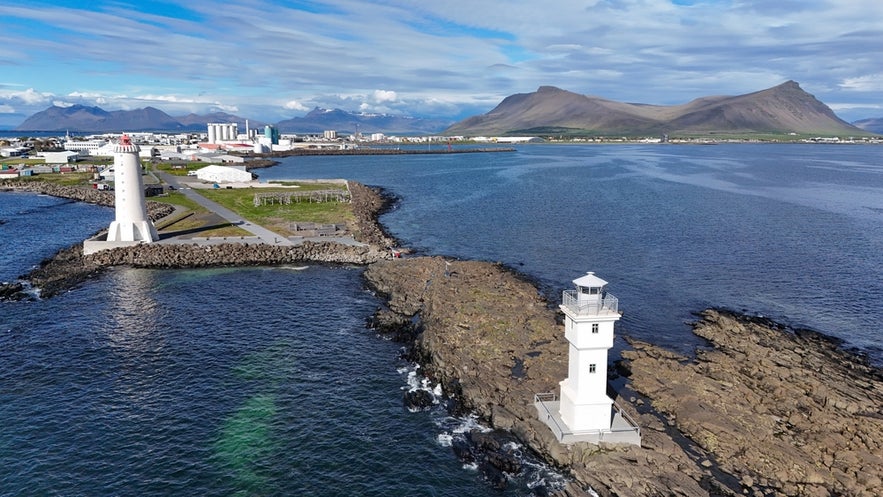How many lighthouses are there in Iceland? What roles have they played in the country's history, and which ones are worth visiting during your trip? This guide will take you through everything you need to know about lighthouses in Iceland, plus how to find them.
Scattered across Iceland’s vast coastline, lighthouses have long served as critical guardians of the sea. With over 3,000 miles (5,000 kilometers) of rugged shoreline, fierce storms, and remote harbors, Iceland’s coastal waters have always demanded careful navigation. Lighthouses weren’t just helpful. They were essential.
Why You Can Trust Our Content
Guide to Iceland is the most trusted travel platform in Iceland, helping millions of visitors each year. All our content is written and reviewed by local experts who are deeply familiar with Iceland. You can count on us for accurate, up-to-date, and trustworthy travel advice.
Today, more than 100 lighthouses stand throughout the country. Some are still active; others serve as historical landmarks and scenic viewpoints. Each one has a story to tell of shipwrecks and safe returns, of architecture shaped by nature, and of solitude in the face of the elements.
Whether you're birdwatching on remote sea cliffs, strolling coastal trails near Reykjavik, or planning to rent a car and embark on self-drive tours around Iceland, lighthouses are quiet treasures scattered across the landscape. This guide will take you through the most iconic, accessible, and unforgettable lighthouses to visit, plus history, travel tips, and preservation efforts along the way.
Key Takeaways
-
Iceland maintains over 100 lighthouses, many located in dramatic, scenic, and remote coastal settings.
-
Some lighthouses, like Grotta and Akranesviti, are easily accessible, while others — like Thridrangar — require more adventurous travel.
-
Many lighthouses are no longer operational, but efforts are underway to preserve and restore them for cultural and tourism purposes.
-
Wildlife, architecture, and history all converge at these coastal landmarks — some even double as puffin-viewing hotspots in summer.
- Learn more about Iceland's buildings with the History of Icelandic Architecture
Guiding Lights on Iceland’s Rugged Shores
 Before ports or proper coastal infrastructure appeared, Icelanders lit fires atop hills or used church steeples along the shoreline to guide their loved ones safely back from the sea. Long before GPS or radar, light was the only lifeline through winter storms, towering swells, and unrelenting fog.
Before ports or proper coastal infrastructure appeared, Icelanders lit fires atop hills or used church steeples along the shoreline to guide their loved ones safely back from the sea. Long before GPS or radar, light was the only lifeline through winter storms, towering swells, and unrelenting fog.
Many of these early beacons were part of Iceland’s most beautiful churches, which played a surprising role in the country’s maritime past.
With a history shaped by seafaring and survival, Iceland developed an enduring relationship with the ocean, and, by extension, a deep reverence for lighthouses. These structures weren’t just tools for navigation; they were symbols of survival, built to withstand some of the harshest coastal conditions on Earth.
The first official lighthouse in Iceland, Reykjanesviti, was constructed in 1878 on the southern tip of the Reykjanes Peninsula. Since then, more than 100 lighthouses have been built along Iceland’s 3,107-mile (5,000-kilometer) coastline. Some are perched on isolated cliffs, while others are nestled between tranquil harbors.
The Icelandic word for lighthouse, viti, comes from the verb vita, which means “to know.” A fitting name for a structure designed to show the way, whether through treacherous waters or thick coastal mist.
Iceland’s lighthouses are more than just functional maritime structures; they’re cultural landmarks that offer a window into the country’s seafaring past. Many are perched in breathtaking locations, from wave-battered cliffs to remote fjords, providing travelers with unforgettable views and a deeper connection to Iceland's coastal identity.
Not-To-Miss Lighthouses Across Iceland
 Before we dive into individual highlights, here’s a quick look at some of Iceland’s most memorable lighthouses. Whether you're planning your itinerary or just curious about what makes each one special, this list offers a quick look at Iceland’s standout lighthouses. Each one is memorable for its location, design, history, or sheer wow factor.
Before we dive into individual highlights, here’s a quick look at some of Iceland’s most memorable lighthouses. Whether you're planning your itinerary or just curious about what makes each one special, this list offers a quick look at Iceland’s standout lighthouses. Each one is memorable for its location, design, history, or sheer wow factor.
-
Most Photogenic: Svortuloft, Gardskagaviti, and Thridrangar
-
Most Accessible: Grotta (near Reykjavik), Akranesviti, and Reykjanesviti
-
Best for Puffin Watching: Dyrholaey, Bjargtangar, and Svortuloft
-
Most Remote: Thridrangar and Dalatangaviti
-
Oldest: Reykjanesviti (originally built in 1878)
-
Most Architecturally Unique: Knarraros Lighthouse
-
Westernmost in Europe: Bjargtangar Lighthouse
Iceland’s Most Iconic Lighthouses
 From their humble beginnings as hillside fires to the weather-beaten towers that dot the coast today, Iceland’s lighthouses have evolved alongside the island’s deep connection to the sea. Each one marks more than a navigational point — they represent resilience, ingenuity, and an Icelandic blend of function and beauty.
From their humble beginnings as hillside fires to the weather-beaten towers that dot the coast today, Iceland’s lighthouses have evolved alongside the island’s deep connection to the sea. Each one marks more than a navigational point — they represent resilience, ingenuity, and an Icelandic blend of function and beauty.
Whether you’re chasing coast views, historic charm, or a perfect windswept photo, here are some of the most captivating lighthouses to visit across the country.
Grotta Lighthouse — A Coastal Escape in Reykjavik
 Over 3 miles (5 kilometers) from Hallgrimskirkja Church in central Reykjavik, Grotta Lighthouse offers a retreat at the edge of the capital.
Over 3 miles (5 kilometers) from Hallgrimskirkja Church in central Reykjavik, Grotta Lighthouse offers a retreat at the edge of the capital.
Located in the peninsula town of Seltjarnarnes, this beloved lighthouse is a popular spot for residents and visitors to enjoy the sea air and sweeping views. On dark winter nights, it also offers a chance to experience the northern lights in Reykjavik.
A lighthouse has stood at Grotta since 1897, though the area’s history goes back even further, with a farmstead occupying the site as early as the 16th century. The current structure was built in 1947 and, aside from being connected to the electrical grid in 1956, has remained largely unchanged ever since.
The protected Grotta Nature Reserve surrounds the lighthouse, established in 1974 to safeguard the abundant birdlife. The area is interwoven with walking and cycling paths, and the view across Faxafloi Bay makes it one of the most picturesque spots within city reach.
Visiting Iceland in summer? Be aware that sections of the reserve are closed off in June to protect nesting birds. And yes, the locals aren’t joking when they warn you about dive-bombing Arctic terns. Cross into restricted areas, and you may earn both a fine and a sharp peck on the head.
Note, too, that access to Grotta Lighthouse is based on the tides. At high tide, the path across the sandbar is submerged, so plan your visit around low tide if you’d like to get up close.
Travel Tips
-
How To Visit: Easily accessible by rental cars, public Straeto bus, bike, or on foot from downtown Reykjavik.
-
Pro Tip: Visit at sunset for ocean views and peaceful scenery, or return on a dark winter night for a chance to see the northern lights.
- See also: Sightseeing in Reykjavik
Reykjanesviti — Iceland’s Oldest Lighthouse
 Standing tall on the windswept cliffs of the Reykjanes Peninsula, Reykjanesviti holds the distinction of being Iceland’s oldest lighthouse and one of its most iconic.
Standing tall on the windswept cliffs of the Reykjanes Peninsula, Reykjanesviti holds the distinction of being Iceland’s oldest lighthouse and one of its most iconic.
The original tower was constructed in 1878 along the peninsula’s southwestern edge, serving as a critical landfall light for ships heading to Keflavik and Reykjavik. Unfortunately, it was destroyed by an earthquake eight years later.
In 1929, the current lighthouse, a 102-foot (31-meter) concrete tower with a classic design, was built in its place, standing strong ever since.
A two-story keeper’s residence was later added nearby, and in a rarity for modern lighthouses, Reykjanesviti has an active lighthouse keeper to this day. This enduring human presence adds a layer of tradition and continuity that many other lighthouses in Iceland have long since lost.
With steam vents, lava fields, and the roaring Atlantic all within view, Reykjanesviti is more than a navigational relic. It’s a living monument to Iceland’s maritime heritage, and a worthy stop for anyone exploring the Reykjanes loop.
Travel Tip
-
How To Visit: The lighthouse is reachable by car or through guided Reykjanes tours.
Suggested Tours
-
Reykjanes Volcano & Sightseeing Tour: A day trip from Reykjavik featuring geothermal areas, lava fields, volcanic landscapes, and a scenic stop near Reykjanesviti Lighthouse.
-
Small Group Reykjanes Tour With Optional Blue Lagoon Drop-Off: Explore dramatic coastal cliffs and volcanic hotspots with optional drop-off at the Blue Lagoon or Keflavik Airport, making it ideal for your arrival or departure day.
Akranesviti — Twin Beacons of the West Coast
 Photo from Wikimedia, Creative Commons, by Pjt56. No edits made.
Photo from Wikimedia, Creative Commons, by Pjt56. No edits made.
The coastal town of Akranes, 31 miles (50 kilometers) north of Reykjavik, is home to not one, but two lighthouses, standing side by side at the edge of the harbor. While the town is better known for its industrial heritage, these striking white towers offer a softer, more scenic side of Akranes, and are well worth the detour for lighthouse lovers and history buffs.
The older of the two lighthouses, built in 1918, is one of the earliest concrete lighthouses in Iceland. In 1944, a larger lighthouse was constructed just a few meters away, and it remains in use today.
Today, the newer Akranesviti not only remains active but also doubles as a small museum and exhibition space dedicated to Icelandic lighthouses and photography. Akranesviti is open from 10 AM to 4 PM daily in the summer, and on weekdays in the winter.
Visitors can climb the spiral staircase to take in panoramic views of the coast and surrounding mountains — a rare treat, as many lighthouses in Iceland are closed to the public.
Quiet and uncrowded, the Akranes lighthouse duo offers a peaceful, windswept stop off the Ring Road, perfect for those craving a mix of maritime history and west coast charm.
 Travel Tips
Travel Tips
-
How To Visit: Best reached by car, Akranesviti is just 45 minutes from Reykjavik via the Hvalfjordur Tunnel.
-
Bonus: Climb the tower and enjoy the photo exhibition when it is open.
Suggested Tours
-
8-Day Ring Road Self-Drive Tour: A flexible summer itinerary covering Iceland’s top sights with time to detour through the Borgarfjordur region and visit Akranes.
-
7-Day Northern Lights Self-Drive Tour: A winter route through West and South Iceland, ideal for exploring Akranes while chasing the aurora.
Dyrholaeyjarviti — Clifftop Views and Coastal Drama in the South
 Photo by Dennis Van Dalen
Photo by Dennis Van Dalen
Perched high above Iceland’s central South Coast, Dyrholaeyjarviti (Dyrholaey Lighthouse) commands one of the most spectacular views in the country.
West of Vik, this compact but striking lighthouse marks the southernmost point of the Icelandic mainland. It's a fitting location for a beacon guiding ships through some of Iceland’s most iconic (and rugged) coastal scenery.
The area surrounding the lighthouse, Dyrholaey, is a nature reserve known for its black sand beaches, dramatic sea cliffs, and panoramic vistas stretching across the South Coast. In the summer months, it’s also a favorite nesting ground for puffins, which can often be spotted bobbing in the surf or perched along the grassy cliffs.
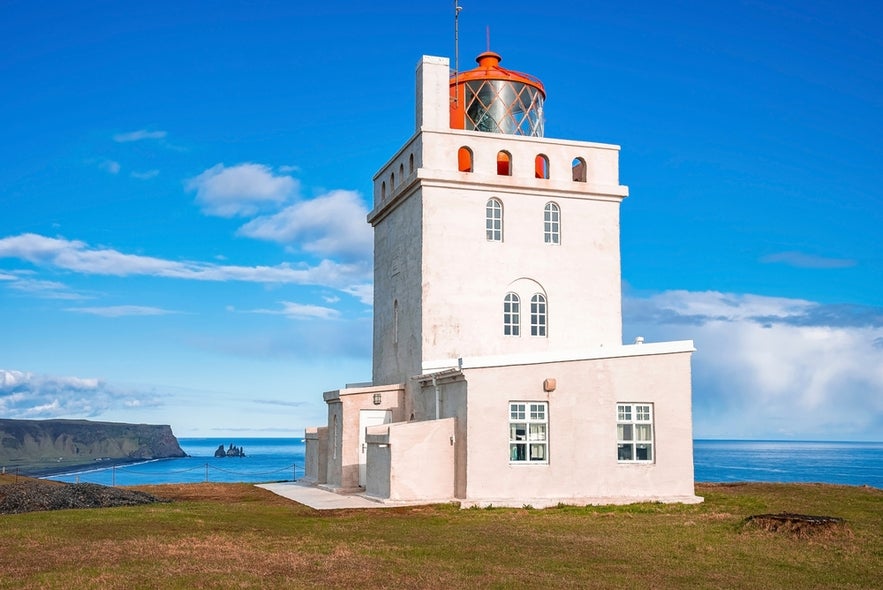 The 43-foot (30-meter) tall lighthouse is not open to visitors, but its presence at the clifftop adds a timeless charm to the landscape. The current tower was completed in 1927, replacing an earlier light station built in 1910.
The 43-foot (30-meter) tall lighthouse is not open to visitors, but its presence at the clifftop adds a timeless charm to the landscape. The current tower was completed in 1927, replacing an earlier light station built in 1910.
One of Dyrholaey’s most famous features lies below the cliffs: a massive natural sea arch, carved by centuries of pounding waves.
In 1993, a daredevil pilot famously flew a small plane cleanly through the arch — an audacious stunt that speaks to the scale of this coastal landmark.
Though you can't enter the lighthouse, a walk along the headland is a South Coast must — especially if you're chasing views that look like they belong on another planet.
Suggested Tours
-
2-Day Summer Adventure Tour: A packed itinerary covering waterfalls, black sand beaches, glacier hikes, and coastal views, with a stop at Dyrholaey.
-
2-Day Winter South Coast Tour: A winter adventure that features ice caves, Diamond Beach, and South Coast cliffs like those near Dyrholaey.
Gardskagaviti — A Colorful Beacon at the Edge of Reykjanes
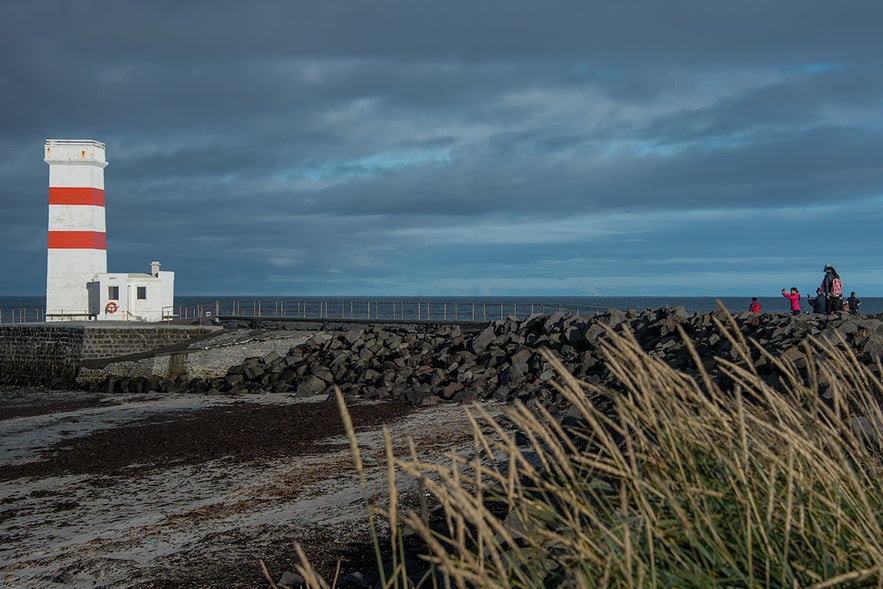 Photo from Wikimedia. Creative Commons. by Emstur. No edits made.
Photo from Wikimedia. Creative Commons. by Emstur. No edits made.
At the northern tip of the Reykjanes Peninsula, northwest of Keflavik International Airport (KEF), you will find not one, but two lighthouses standing watch over the windswept shoreline. Painted in bright bands of red and white, the taller of the pair, Gardskagaviti, stands out boldly against the muted tones of sea and sky.
The older lighthouse was first constructed in 1897 as a timber tower by the Danish Lighthouse Commission, later reinforced with concrete in 1933. However, due to concerns about erosion and landslides, it was decommissioned in 1944.
 That same year, the current tower was completed just a few meters away. Standing 85 feet (26 meters) tall, it remains in use today. A lighthouse keeper lived on site until 1979, overseeing the light through long winters and turbulent weather.
That same year, the current tower was completed just a few meters away. Standing 85 feet (26 meters) tall, it remains in use today. A lighthouse keeper lived on site until 1979, overseeing the light through long winters and turbulent weather.
While you can’t enter either lighthouse, the location offers peaceful ocean views, seabird sightings, and easy access from the airport. It makes Gardskagaviti a memorable stop, either just after arrival or just before departure.
Travel Tip
-
How To Visit: Rental cars from Keflavik Airport make it easy to stop at the lighthouse after your arrival.
Thirdrangaviti — Iceland’s Most Daring Lighthouse
 Photo from Wikimedia. Creative Commons, by Voilier.Evidence. No edits made.
Photo from Wikimedia. Creative Commons, by Voilier.Evidence. No edits made.
Rising from the open sea like something out of a dream — or a survival movie, Thridrangar Lighthouse is arguably the most dramatic, though remote, lighthouse in Iceland.
Perched atop a 120-foot (36-meter) basalt sea stack, this solitary beacon stands approximately 4.5 miles (2.7 kilometers) off the coast of the Westman Islands. It is surrounded by nothing but wild ocean and sky.
Built in 1938, the construction of the lighthouse was a feat of human determination. Local mountaineers and workers from the Westman Islands scaled the vertical cliff face without modern safety equipment, carving out a narrow path to lay the foundation.
They worked against constant wind, slick rock, and terrifying heights, all to bring light to one of Iceland’s most treacherous maritime zones.
Thridrangar gained global attention through a viral video that showed the lighthouse clinging to its sea stack like something from a fantasy novel. The video sparked a wave of fascination, and it's no wonder — few places on Earth feel so completely cut off from civilization.
Today, Thridrangar is accessible only by helicopter, weather permitting, though it’s important to note that the lighthouse is not open to visitors. Even landing on the sea stack requires special permission and ideal flying conditions, with pilots carefully touching down on a tiny helipad balanced above sheer drops.
A visit here isn’t your typical sightseeing stop — it’s a glimpse into Iceland’s raw, untamed spirit. For most, the lighthouse remains a distant but unforgettable symbol of human grit and isolation.
Travel Tip
-
How To Visit: Public access to Thridrangar is not permitted, even by helicopter. However, you may glimpse the sea stack from afar during a scenic boat tour.
Suggested Tour
-
Small Island Boat Tour From Vestmannaeyjar: While not guaranteed, the tour may offer distant views of the sea stack where Thridrangar Lighthouse stands. Bring binoculars and you will improve your chances of seeing Thridrangar for yourself.
- See also: Top 5 Islands in Iceland
Dalatangaviti — Iceland’s Only Privately Built Lighthouse
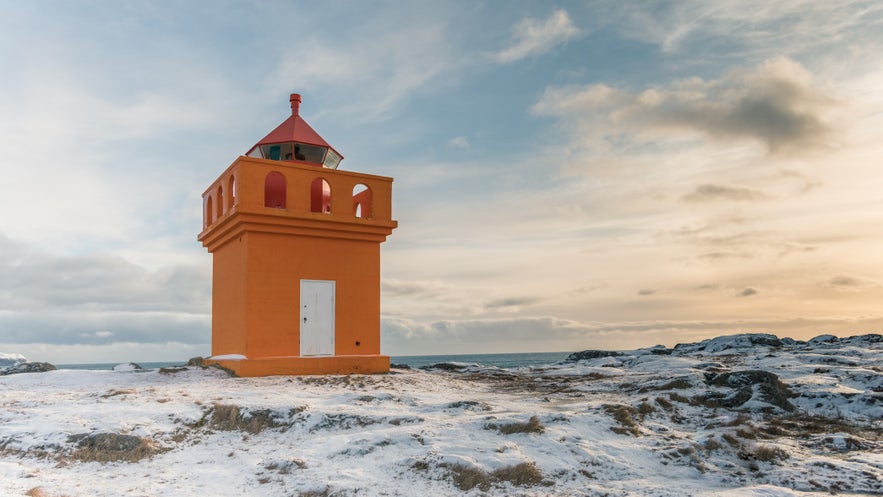 Photo by Ludovic Charlet
Photo by Ludovic Charlet
Tucked away in the remote Eastfjords, Dalatangaviti stands out not only for its wild coastal setting. Its vibrant orange color also makes it one of Iceland’s most visually striking lighthouses.
Reaching it involves a scenic detour down a dirt road from the Mjoifjordur Fjord, where cascading waterfalls and dramatic fjord views make the journey as rewarding as the destination.
The original lighthouse was built in 1895 by Otto Wathne, a shipowner and entrepreneur. Remarkably, it's the only lighthouse in Iceland constructed by a private individual. It was decommissioned in 1917 and gradually fell into disrepair.
The current lighthouse, painted a now-iconic orange, was built in 1959, about 325 feet (100 meters) from the original site. Today, it’s managed by the National Museum of Iceland as part of the country’s cultural heritage.
From June to October, the MS Norrona Ferry — traveling between Denmark and the town of Seydisfjordur — passes near Dalatangaviti. As Iceland’s only car ferry from mainland Europe, it makes occasional stops in Norway and Scotland, making the lighthouse a fleeting but memorable landmark for seafaring travelers.
Travel Tip
-
How To Visit: Located near Mjoifjordur, this lighthouse is remote but reachable via gravel roads or guided excursions.
Suggested Tours
-
Secret Fjord Jeep Tour: A small-group 7-hour super jeep tour from Seydisfjordur, showcasing hidden waterfalls, dramatic fjord views, and the remote road leading to Dalatangaviti.
-
Private Tour of Mjoifjordur: A five-hour private journey through one of Iceland’s most secluded fjords, complete with stories of trolls, waterfalls, and a stop at the Dalatangaviti lighthouse itself.
- See also: Best Places To Visit in East Iceland
Bjargtangar Lighthouse — Europe’s Western Edge
 Photo from Wikimedia, Creative Commons, by Martin Cigler. No edits made.
Photo from Wikimedia, Creative Commons, by Martin Cigler. No edits made.
You’ll find Bjargtangar Lighthouse at the far edge of the Westfjords, where towering cliffs plunge into the Atlantic Ocean. It is a humble white tower that quietly marks the westernmost point of both Iceland and Europe.
The first lighthouse at Bjargtangar was established in 1913 to mark the westernmost point of Iceland and Europe. The original structure was later replaced in 1948 by the current two-story concrete tower, designed with a stark, utilitarian style.
Though closed to visitors, the lighthouse stands on a high cliff with a focal height of nearly 200 feet (60 meters) above sea level, offering expansive views over the North Atlantic.
Bjargtangar sits at the edge of the Latrabjarg Bird Cliffs, one of Europe’s largest seabird colonies and a haven for puffins, guillemots, razorbills, and more. The cliffs stretch for 8.7 miles (14 kilometers) and soar up to 1,447 feet (441 meters) — a natural mural buzzing with birdlife in the summer months.
 Because Arctic foxes can’t reach the narrow cliff ledges where many birds nest, the seabirds at Latrabjarg are unusually tame, allowing visitors to get surprisingly close. It’s a dream location for birdwatchers, photographers, and anyone craving raw, untouched wilderness.
Because Arctic foxes can’t reach the narrow cliff ledges where many birds nest, the seabirds at Latrabjarg are unusually tame, allowing visitors to get surprisingly close. It’s a dream location for birdwatchers, photographers, and anyone craving raw, untouched wilderness.
Though the lighthouse itself is modest, its location at the edge of the world is anything but. Standing near it, with seabirds circling overhead and cliffs falling away into mist, you’ll understand why this spot is often described as one of Iceland’s most unforgettable.
Travel Tip
-
How To Visit: The lighthouse is best reached by car through the Westfjords. Located beside the famous Latrabjarg bird cliffs, it's ideal for adventurous travelers with a bit more time.
Suggested Tours
-
The Bird Cliffs of Latrabjarg Hiking Tour: A scenic day hike through the Latrabjarg Cliffs, offering close-up encounters with birdlife and the chance to explore the surrounding area near Bjargtangar.
-
9-Hour Jeep Tour to Latrabjarg Cliffs and Raudasandur Beach: A guided jeep adventure through the highlights of the Westfjords, including beaches, fjords, and the Latrabjarg Cliffs near the lighthouse.
Svortuloft Lighthouse — Orange Against the Ocean

Perched on the dramatic western edge of the Snaefellsnes Peninsula, Svortuloft Lighthouse is impossible to miss. Its bold orange tower stands in stark contrast to the surrounding black lava cliffs, where the Atlantic Ocean crashes below and seabirds nest in the jagged rock.
Built in 1931, the current structure is a square tower — rugged and utilitarian, but beautifully set against the wild coastal scenery of Snaefellsjokull National Park. It replaced an earlier lighthouse built in 1914 and continues to serve as a navigational point along this remote stretch of coastline.
The name Svortuloft translates to “black ceiling,” a reference to the shadowy cliff overhangs that define this part of the coast. A short walk from the parking area leads you past jagged lava fields to a viewing platform ideal for watching waves, seabirds, and even the occasional seal or whale offshore.
Though less visited than other spots on the peninsula, Svortuloft offers a striking detour. It's one of the most photogenic stops in West Iceland — especially during golden hour, when the lighthouse seems to glow against the basalt.
Travel Tips
-
How To Visit: The lighthouse is best reached by car. Located on the westernmost tip of the Snæfellsnes Peninsula, Svortuloft is accessible via a gravel road branching off from Route 574 within Snaefellsjokull National Park.
-
Reminder: In winter, access can be difficult or impassable, and a 4x4 vehicle is recommended year-round due to uneven terrain. Always check local conditions before heading out.
Suggested Tour
-
10-Day Self-Drive Tour of the Ring Road: This comprehensive road trip around Iceland includes a day on the Snaefellsnes Peninsula, offering plenty of time to visit Svortuloft and other West Iceland highlights at your own pace.
Knarraros Lighthouse — Art Deco Meets the South Coast
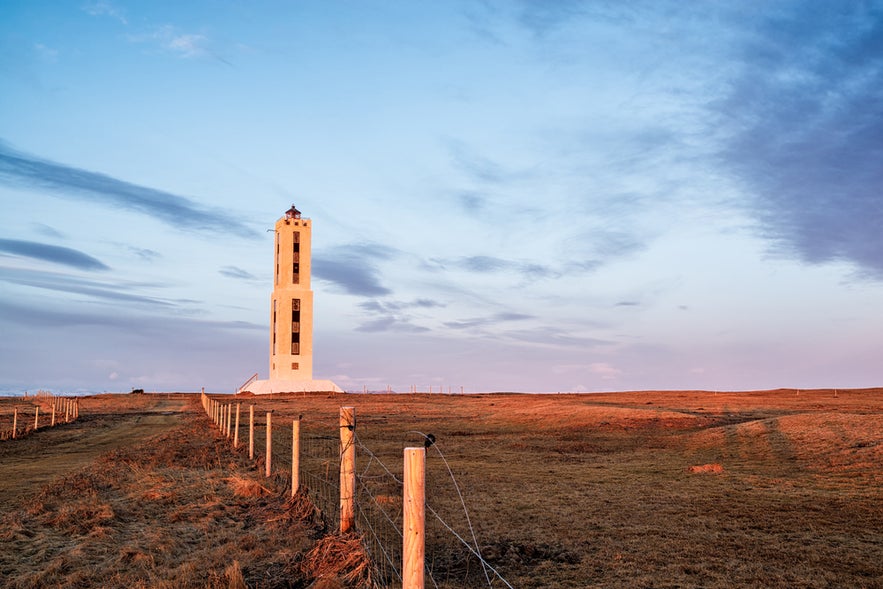 Located about 3.1 miles (5 kilometers) from the coastal village of Stokkseyri, Knarraros Lighthouse stands out among Iceland’s lighthouses. Its striking design is just as notable as its seaside setting.
Located about 3.1 miles (5 kilometers) from the coastal village of Stokkseyri, Knarraros Lighthouse stands out among Iceland’s lighthouses. Its striking design is just as notable as its seaside setting.
Built in 1939, the tower is an architectural blend of Art Nouveau and Functionalist styles, a rare sight in Icelandic lighthouse construction.
The lighthouse was designed by civil engineer Axel Sveinsson. His work was heavily influenced by Guðjón Samúelsson, Iceland’s famed state architect, who also designed landmarks like Hallgrimskirkja Church and the National Theatre.
The structure rises 85 feet (26 meters) and is made up of two stacked forms. Left unpainted, it features sleek black paneling that gives it a moody, modernist elegance, especially when viewed against the often gray backdrop of the South Coast sky.
It's a peaceful and lesser-known stop for travelers exploring the southern lowlands, offering a quiet dose of history, design, and solitude by the sea.
Travel Tip
-
How To Visit: It's best reached via self-drive, just a short detour from the coastal village of Stokkseyri. While the lighthouse itself is closed to the public, visitors can enjoy the seaside setting and explore nearby attractions. Stokkseyri is known for its charming harbor, seafood restaurants, and calm waters perfect for kayaking.
Suggested Tour
-
7-Day Self-Drive Tour of the Complete Ring Road of Iceland: This week-long itinerary covers Iceland’s top regions, including the South Coast. Knarraros Lighthouse makes for a peaceful and scenic stop near the beginning or end of your journey.
Preservation & Recent Developments
 Though many of Iceland’s lighthouses are no longer critical for navigation, they remain deeply valued as cultural landmarks, symbols of resilience, and destinations in their own right. In recent decades, efforts to preserve and restore these coastal beacons have gained momentum, often thanks to a handful of passionate individuals.
Though many of Iceland’s lighthouses are no longer critical for navigation, they remain deeply valued as cultural landmarks, symbols of resilience, and destinations in their own right. In recent decades, efforts to preserve and restore these coastal beacons have gained momentum, often thanks to a handful of passionate individuals.
One such person is Ingvar Hreinsson, a dedicated mason who has spent over 20 years repairing lighthouses across Iceland. By 2016, he had worked on all 104 of them — a quiet legacy of craftsmanship and care that has kept these structures standing strong against Iceland’s famously unforgiving weather.
In Reykjavik, a new lighthouse and viewing platform were added to the waterfront in 2019. Though small, it’s symbolic of the city’s continued connection to the sea and offers locals a scenic, accessible way to engage with maritime history.
As interest in Iceland’s lesser-known landmarks continues to grow, lighthouses remain quiet sentinels on the coast. It welcomes not only ships but travelers seeking beauty, solitude, and stories etched into stone.
FAQs About Lighthouses in Iceland
Curious to know more about Iceland’s lighthouses? Here are some of the most commonly asked questions:
How many lighthouses are there in Iceland?
There are approximately 104 lighthouses scattered around Iceland’s 3,100-mile (5,000-kilometer) coastline. While many are operational, others have been decommissioned and serve as historical landmarks or scenic viewpoints.
Can you go inside any of the lighthouses in Iceland?
Most Icelandic lighthouses are closed to the public, but a few, like Akranesviti, offer seasonal access, exhibitions, or observation decks. Even when entry isn’t possible, many are located in stunning coastal settings that are well worth the visit.
What’s the best time of year to visit Iceland’s lighthouses?
Lighthouses can be visited year-round, but summer (June–August) offers the best accessibility, weather, and wildlife viewing — especially for puffins. In winter, some become popular northern lights viewing spots, like Grotta Lighthouse near Reykjavik.
Are the lighthouses easy to reach?
Some lighthouses, like Grotta, Akranesviti, and Reykjanesviti, are easily accessible by car, often with paved roads and short walks. Others, like Dalatangaviti or Bjargtangar, require navigating gravel roads and remote terrain.
Can I sleep in a lighthouse in Iceland?
Not quite. The Dyrolaey Lighthouse once operated as a hotel for a few years, but it is now closed. There are currently no operational lighthouses in Iceland that double as hotels or guesthouses.
A few are located near cozy coastal accommodations, and some — like Akranesviti — offer cultural exhibitions that are open during the day. If you're dreaming of a night by the sea, your best bet is to stay nearby and visit during daylight hours for the full lighthouse experience.
Iceland’s Beacons of Light & Legacy
 From solitary towers clinging to sea stacks to coastal landmarks guiding travelers home, Iceland’s lighthouses offer more than just maritime utility. They offer stories, stillness, and unforgettable views. Each one, whether towering or humble, plays a role in the island’s rugged, sea-bound identity.
From solitary towers clinging to sea stacks to coastal landmarks guiding travelers home, Iceland’s lighthouses offer more than just maritime utility. They offer stories, stillness, and unforgettable views. Each one, whether towering or humble, plays a role in the island’s rugged, sea-bound identity.
As you explore Iceland’s coastlines, these beacons stand ready to greet you. Whether tracing history, chasing wildlife, or simply soaking in the view, Iceland's lighthouses are well worth the stop.
Did you enjoy our article about lighthouses in Iceland? Which Icelandic lighthouses have you visited? Which lighthouse was your favorite? Leave your thoughts and queries in the Facebook comments box below.

